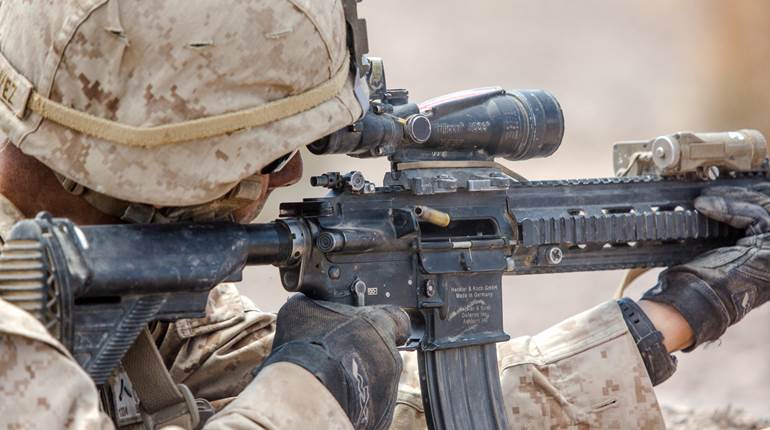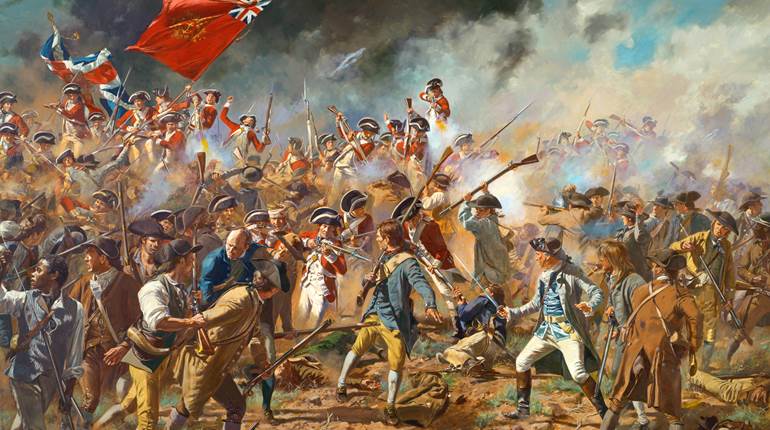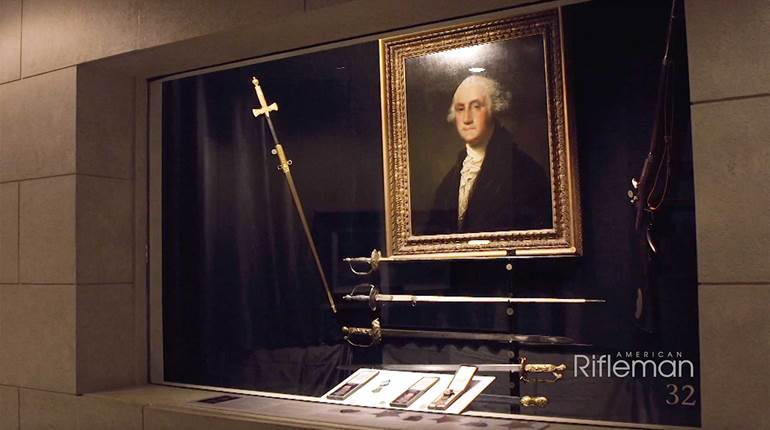
5/30/2013
At New Orleans, the final battle of the War of 1812, riflemen played a crucial role in the crushing British defeat. William Ross and his John Jacob Sheetz-made longrifle—the only one with such provenance—were there, and it is an important artifact in the narrative of American freedom.
William Ross stood looking intently through a dissipating fog over the American breastworks constructed at the behest of Gen. Andrew Jackson. It was Jan. 8, 1815, and the Battle of New Orleans would soon begin. Ross, a family man with five sons and a daughter, was dressed in a blue hunting shirt, belted at the waist and wearing a black slouch hat. The garb identified him as a member of Thomas Beale’s Volunteer Riflemen, a local militia group 68 strong, that was formed in mid-December 1814. Most of the men originally hailed from Virginia, but for one reason or another had migrated to New Orleans. Many were prominent businessmen and civic leaders, including Ross, whose occupation was inspecting shipments of flour, which came by the ton into the port of New Orleans. Clutched in his right hand was a long-barreled rifle.
William Ross would contribute to the American victory that day. The rifle he carried has survived for two centuries and emerged from obscurity to tell the story of its beginnings—eyewitness to a battle that helped shape and define the United States and its destiny. As of today, it is the only documented, verifiable longrifle that can make that claim.
The builder of Ross’ flintlock longrifle was John Jacob Sheetz, 1785-1860. He lived in Shepherdstown, Va., (now West Virginia). John’s father, Phillip, and his brother, Martin, were also gunsmiths, known for their excellent workmanship. Phillip apprenticed under George Unkafare of York County, Penn., in 1760 and later taught John the skills needed to build an accurate shooting, artistically decorated longrifle from the ground up; lock, stock and barrel. Today, we refer to William Ross’ gun as the Sheetz rifle. It is a testimony to the gun building talent of John Jacob Sheetz.
The longrifle is a uniquely American gun design, borrowing technologies from Germany and other European countries to create a long-barreled, accurate firearm, well adapted to the needs of frontier Americans. Though firearms in this class share many characteristics, such as their long, rifled barrels, individual examples are unique works, heavily influenced not only by the gunsmiths who made them but also by their regions of origin. William Ross’ longrifle was made in Virginia, and it reflects that in its styling.
The Sheetz rifle is an excellent example of a flintlock longrifle made in what is known as the Golden Age, the time frame when these guns reached the zenith of their architectural design and artistic development—loosely from the American Revolution to 1830. The gun is in fine original condition, a repair to the weak sear spring would render it shootable. The .38-cal. wrought-iron barrel has 1:36-inch twist rifling.
Robert and Linda Melancon, present owners of the Sheetz rifle, provide this description: “The gun is in original flint condition, with an original hand-forged lock and marked clearly on the top flat of the 42-inch barrel ‘J. SHEETZ.’ The wood is curly maple, with fine forestock molding and it retains its original ramrod. There is classic Virginia carving at the rear of the cheekpiece, going from fine incised carving to very subtle raised carving on the large C scroll with a fan design directly to the rear of it. In front of the cheek piece is another C scroll with cross-hatching. The wrist area, behind the barrel tang, carries incised carving of a four-petal flower (identified as edelweiss). The brass patchbox is a typical Virginia style with a finely engraved ... flower finial similar to the wrist carving. Engraved on the patchbox lid is the following inscription: ‘this rifle was used by my father Wm. Ross, member of Capt. Tho. Beale’s Company of New Orleans riflemen in defense of N. Orleans. 1814-1815. James Ross 1837’.” James was William’s son and the executor of his will. Curiously, somebody crudely attempted to scratch William Ross’s name and the 1837 date off the patchbox lid. No one knows who, when or why.
The Americans were equipped with around 2,000 longrifles the morning of Jan. 8, 1815. As the British Army under Maj. Gen. Sir Edward Pakenham moved toward Jackson’s line around seven o’clock, 7,000 of the best equipped and disciplined soldiers in the world marched with determination and resolve through a swampy marshland to crush the Americans under Jackson and capture the port city of New Orleans. If they succeeded, Great Britain would gain control of the Mississippi River, the consequences of which would be dire. England could choke the western commerce of the United States, crippling the economy. Many rivers west of the Allegheny and Appalachian Mountains drained into the Mississippi, creating a watery highway that people used to move their goods and products to New Orleans. Further, the British would certainly pillage and plunder the city, then use its occupation as a powerful bargaining chip for future negotiations with the United States.
As powerful and successful as any professional army in the world at that time, the British had no reason to think they could fail. For the young United States, the stakes could not have been higher.
Directly to the right of William Ross, as he was facing the battlefield, flowed the Mississippi River. Earlier, Gen. Jackson ordered that the levee be breached in several places, causing the cold, brown waters of the great river to flood the field of battle, which would prove to be a disadvantage to the British. In front of him, at a short distance, was a hastily assembled brick redoubt with mounted cannon that—at all costs—could not fall into the hands of the British army. If captured, the cannon could be turned at an angle to fire down the American line. To his left ran the line of Jackson’s breastworks, 1,600-yards long, varying in width up to 20 feet. standing shoulder high and shored up with wooden planking. The last part terminated in a formidable cypress swamp. The Tennessee and Kentucky riflemen were standing four deep in rows the length of their line. Once the man in front discharged his rifle, he would go to the back of his line and reload while the next would step up and fire, and so on. Cannons had been placed on top of cotton bales at intervals along the breastworks. This was Gen. Jackson’s idea; he realized the soggy and marshy conditions of the battlefield would be an unstable footing for the firing of cannons, causing accuracy to be erratic and unpredictable.
In front of the breastworks flowed Rodriguez Canal, about 4-feet deep by 10-feet wide, which ran from the cypress swamp to the Mississippi River. Those two obstacles, the breastworks and canal, would frustrate the British attack. Jackson had chosen his field of battle wisely; the British army would be funneled into an open, soggy field. To breach the American line they would need to march across an open area, ford the canal and use ladders to scale the breastworks where they would be easy targets for the American sharpshooters, such as Beale’s Riflemen.
The American forces were a rich diversity of men including regular troops, volunteers from Louisiana (Beale’s riflemen), militiamen from Kentucky and Tennessee, men of color, Baratarians (pirates connected to Jean Lafitte) and even some Choctaw Indians; it was not a polished, professional army. “The volunteer Rifle companies in Jackson’s line were a sorry sight,” wrote author Tim Pickles. “Their clothing, which was not a uniform to begin with, had become ruined by long marches. It was from these troops that the British got the idea of calling the Americans ‘the Dirtyshirts.’”
The attack began with the British army moving in two columns toward the American line. Major General Samuel Gibb’s Second Brigade moved to attack the side opposite from the field Beale’s riflemen were protecting; their movements would follow the edge of the cypress swamp. Maj. Gen. John Keane moved the Third Brigade along the river in the general direction of Beale’s riflemen, sending some light companies under Col. Robert Rennie to capture the redoubt and turn the cannons back on Jackson’s line.
That is where an important engagement took place that would involve Ross and his rifle. American military engineer Maj. A. Lacarriere Latour gave this eyewitness account: “To get into the redoubt was not a very arduous achievement: the difficulty was to maintain possession of it and then clear the breastworks of the entrenchment in the rear of the redoubt, which still remained to be attacked … Colonel Robert Rennie, followed by two other officers of high rank, had begun to mount the breastwork, when the gallant riflemen under Captain Beale, made them find their graves in the redoubt they had mastered with so much gallantry.”
Had Rennie’s men maintained their position on that redoubt next to the river, they would certainly have commandeered the cannons and decimated Jackson’s line along the breastwork, probably changing the outcome of the battle. After a clash that lasted less than an hour, the British army suffered one of the most humiliating defeats in its military history, losing more than 2,000 men of its fighting force, including Maj. Gen. Samuel Gibbs and Maj. Gen. Sir Edward Pakenham. The American army suffered 13 dead, 39 wounded and some missing. Many of the British army’s casualties had multiple gunshot wounds.
Ross would earn $23.48 for his tenure of service in Jackson’s army serving from Dec. 16, 1814 to March 14, 1815. He died on June 19, 1835, and was buried in Girod Cemetery in New Orleans. The Superdome was later built on the graveyard site. His son James inherited the gun, and in 1837 had the commemorative engraving etched on the patchbox lid. In 1982, Robert and Linda Melancon acquired the rifle from the Royal Street shop of James H. Cohen and Sons, Inc., in New Orleans.
The victory that Jackson’s forces won the morning of Jan. 8, 1815, was more than a tactical one. It helped reunite our nation, restored a sense of national pride and served notice to the world that the United States would staunchly defend its sovereignty. It was an improbable, but smashing victory won with the Sheetz rifle and other American long guns, in the hands of patriots like William Ross, who stood shoulder-to-shoulder in the battle line of New Orleans.





































